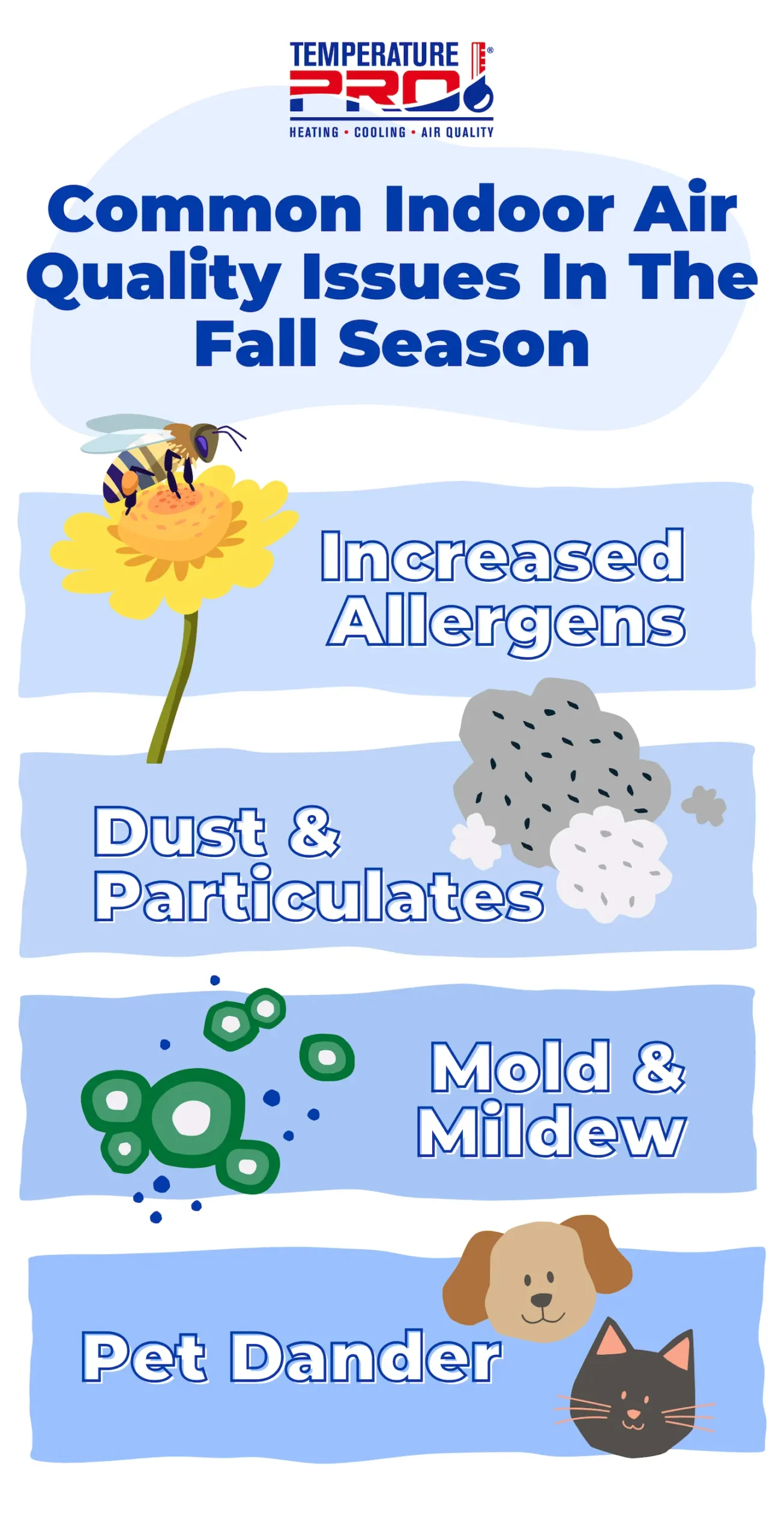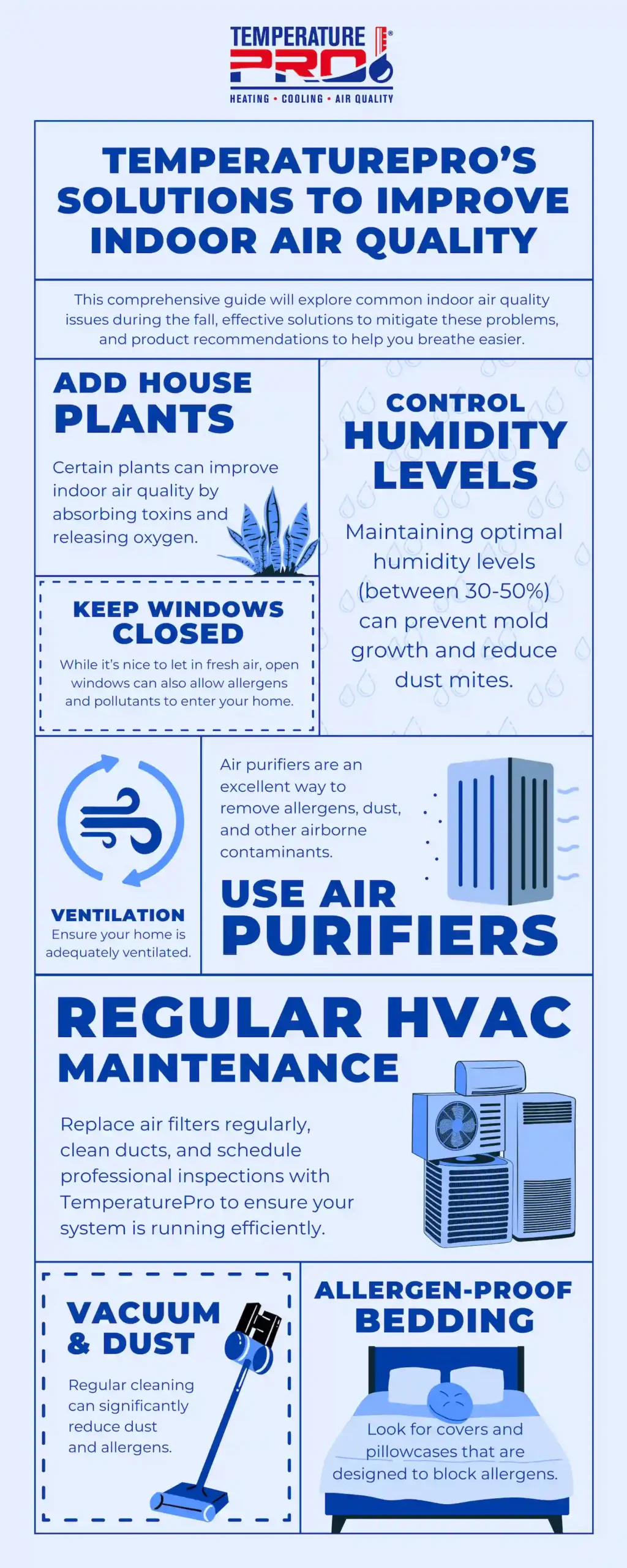Fall is a season of vibrant colors, cooler temperatures, and cozy moments, but it also brings specific challenges for indoor air quality (IAQ). As we transition from the warm days of summer to the cooler autumn months, our homes face increased allergens, dust, and other contaminants that can affect our health and comfort. This comprehensive guide will explore common indoor air quality issues during the fall, effective solutions to mitigate these problems, and product recommendations to help you breathe easier.
Common Indoor Air Quality Issues in the Fall
Increased Allergens
Fall is notorious for triggering allergies. Ragweed pollen, mold spores from decaying leaves, and other airborne allergens become prevalent, making their way into our homes. These allergens can cause sneezing, coughing, itchy eyes, and respiratory issues.
Dust and Particulates
As we close windows and doors to keep out the cold, dust and particulates tend to accumulate indoors. The use of heating systems can stir up dust that has settled in ducts and on surfaces, leading to poor IAQ.
Mold and Mildew
Moist conditions in the fall can promote the growth of mold and mildew, particularly in areas like basements, bathrooms, and around windows. Mold spores can be harmful when inhaled, causing allergic reactions and other health issues.
Pet Dander
With pets spending more time indoors during the colder months, pet dander becomes a significant concern. Dander can exacerbate allergies and asthma symptoms, contributing to poor indoor air quality.

Solutions to Improve Indoor Air Quality
Use Air Purifiers To Remove Unwanted Pathogens
Air purifiers are an excellent way to remove allergens, dust, and other airborne contaminants. Look for purifiers with HEPA filters, which can capture particles as small as 0.3 microns.
TemperaturePro Recommended Product: Our partnerships allow us to get leading industry air purifiers that will work seamlessly with your existing HVAC. Whether you need a portable air purifier, or an addition to your HVAC system, we’ve got you covered.
Regular HVAC Maintenance Can Prevent Airborne Contaminants
Proper HVAC maintenance is crucial for maintaining a positive IAQ. Replace air filters regularly, clean ducts, and schedule professional inspections to ensure your system is running efficiently.
TemperaturePro Service Recommendation: Scheduling your Maintenance Visit, and TemperaturePro ProPlan Memberships
Through our membership programs, we are able to provide you with more benefits, more savings, and more customer service. With bi-annual maintenance visits that work on your schedule, membership discounts, priority scheduling, and no overtime charges, our ProPlan memberships become more than just HVAC maintenance, they become a necessity. Become a member today by calling your local TemperaturePro.
Add Houseplants That Promote Healthy Air
Certain houseplants can improve air quality by absorbing toxins and releasing oxygen. Plants like spider plants, snake plants, and peace lilies are particularly effective. However, when choosing indoor plants, it’s necessary to take into consideration any pets or young children you may have in the house. Some plants can be toxic when ingested by animals or small children, so put them in a high place, hang them, or choose a plant that won’t release toxins if it found its way into your pet’s mouth. Consider things like lighting in your home (artificial as well as natural light), location, maintenance necessary, and watering schedule.
Recommended Plant: Snake Plant – you can find these and many other common and useful houseplants at local nurseries in your area. Most nursery employees and licensed horticulturists (plant specialists) can recommend a perfect houseplant to fit your exact needs.
Control Humidity Levels To Promote Healthy Indoor Air
Maintaining optimal humidity levels (between 30-50%) can prevent mold growth and reduce dust mites. Use dehumidifiers in damp areas and humidifiers when the air is too dry.
TemperaturePro Recommendation: Your environment will determine whether you need a humidifier or a dehumidifier in your home (example, a dry cold and a humid cold). However, most heating systems commonly make the air dryer when running. At TemperaturePro, we have heating systems that work to keep your humidity at optimal levels for your home, as well as many solutions we can add to existing HVAC systems. Call your local TemperaturePro for more details and we can recommend a product that works perfectly for your situation.
Ventilation Is Required To Get Rid of Any Particles Already In The Home
Ensure your home is adequately ventilated. Use exhaust fans in kitchens and bathrooms, and consider installing a whole-house ventilation system to circulate fresh air and reduce indoor pollutants.
Recommended Tip: Call a professional to ensure your home is properly ventilated.
Vacuum and Dust Regularly To Remove Stagnant Pollutants
Regular cleaning can significantly reduce dust and allergens. Use a vacuum with a HEPA filter to trap small particles, and dust surfaces with microfiber cloths to capture dust rather than spreading it.
Recommended Schedule: Vacuum and dust at least once a week if you can. Choosing a vacuum that can easily switch from carpet to solid floors can help make the task more efficient, as well as a wet/dry vacuum. Be sure to look at reviews of popular name brands to get the best fit for your home.
Keep Windows Closed During Peak Pollen Times of Day
While it’s nice to let in fresh air, open windows can also allow allergens and pollutants to enter your home. Keep windows closed during high pollen times and on windy days.
Use Allergen-Proof Bedding
Allergen-proof bedding can reduce exposure to dust mites and other allergens while you sleep. Look for covers and pillowcases that are designed to block allergens.

Product Recommendations for Improving Indoor Air Quality
Air Quality Monitors With Real-Time Data
Air quality monitors can help you keep track of indoor air pollution levels and take action when necessary.
TemperaturePro Recommendation: We have access to many different industry-leading products that allow you to monitor your current indoor air quality performance, at any time! We recommend reaching out to your local TemperaturePro and asking about what IAQ monitoring products are available.
HEPA Filters – High Efficiency Particulate Air Filters Can Remove More
HEPA filters are highly effective at capturing small particles and are essential for maintaining clean air. HEPA stands for High Efficiency Particulate Air (filter) which, according to the EPA, can remove up to 99.97% of harmful airborne particles! Investing in these filters now can ensure that those harmful particles such as dust, mold and pollen will stay outside of your home, where they belong.
UV Air Purifiers Use Light To Filter Out Pollutants
UV air purifiers can help eliminate bacteria, viruses, and mold spores, providing an extra layer of protection.
Recommendation from TemperaturePro: Have your local TemperaturePro tech visit and inspect your HVAC System. We then can provide you with a custom solution that fits your exact specifications, seamlessly integrating within your existing setup.
Use TemperaturePro to Improve Your Indoor Air Quality With Custom Solutions Just For You
Improving indoor air quality during the fall is essential for maintaining a healthy and comfortable home environment. By addressing common issues like increased allergens, dust, and mold, and implementing effective solutions such as using air purifiers, regular HVAC maintenance, and adding houseplants, you can significantly enhance the air you breathe. With the right products and practices, you can create a safe and welcoming space for you and your loved ones throughout the autumn months.
Stay proactive in managing your indoor air quality, and make use of the resources and product recommendations provided to ensure a healthier home this fall. Breathe easy and enjoy the season with peace of mind at TemperaturePro.
TemperaturePro Provides Research and Reputable Sources For All Of Our Information
- American Lung Association: Provides detailed information on indoor air quality and its impact on health. Visit Site
- Environmental Protection Agency (EPA): Offers guidelines and tips for improving indoor air quality. Visit Site
- Centers for Disease Control and Prevention (CDC): Shares insights on mold and moisture control to maintain healthy indoor environments. Asthma and Allergy Foundation of America (AAFA): Provides resources for managing indoor allergens and asthma triggers. Visit Site
- National Institute for Occupational Safety and Health (NIOSH): Offers information on indoor environmental quality and related health concerns.






